-
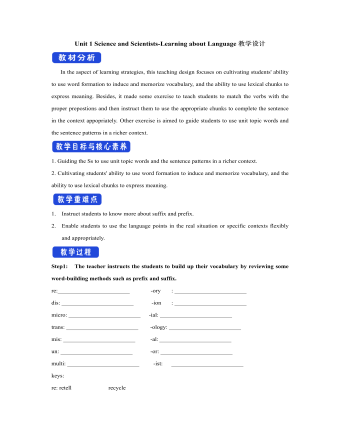
新人教版高中英语选修2Unit 1 Science and Scientists-Learning about Language教学设计
Step 7: complete the discourse according to the grammar rules.Cholera used to be one of the most 1.__________ (fear) diseases in the world. In the early 19th century, _2_________ an outbreak of cholera hit Europe, millions of people died. But neither its cause, 3__________ its cure was understood. A British doctor, John Snow, wanted to solve the problem and he knew that cholera would not be controlled _4_________ its cause was found. In general, there were two contradictory theories 5 __________ explained how cholera spread. The first suggested that bad air caused the disease. The second was that cholera was caused by an _6_________(infect) from germs in food or water. John Snow thought that the second theory was correct but he needed proof. So when another outbreak of cholera hit London in 1854, he began to investigate. Later, with all the evidence he _7_________ (gather), John Snow was able to announce that the pump water carried cholera germs. Therefore, he had the handle of the pump _8_________ (remove) so that it couldn't be used. Through his intervention,the disease was stopped in its tracks. What is more, John Snow found that some companies sold water from the River Thames that __9__________________ (pollute) by raw waste. The people who drank this water were much more likely _10_________ (get) cholera than those who drank pure or boiled water. Through John Snow's efforts, the _11_________ (threaten) of cholera around the world saw a substantial increase. Keys: 1.feared 2.when 3. nor 4.unless 5.that/which 6.infection 7.had gathered 8.removed 9.was polluted 10.to get 11. threat
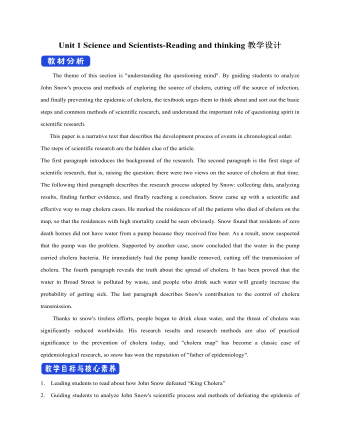
新人教版高中英语选修2Unit 1 Science and Scientists-Reading and thinking教学设计
Step 5: After learning the text, discuss with your peers about the following questions:1.John Snow believed Idea 2 was right. How did he finally prove it?2. Do you think John Snow would have solved this problem without the map?3. Cholera is a 19th century disease. What disease do you think is similar to cholera today?SARS and Covid-19 because they are both deadly and fatally infectious, have an unknown cause and need serious public health care to solve them urgently.keys:1. John Snow finally proved his idea because he found an outbreak that was clearly related to cholera, collected information and was able to tie cases outside the area to the polluted water.2. No. The map helped John Snow organize his ideas. He was able to identify those households that had had many deaths and check their water-drinking habits. He identified those houses that had had no deaths and surveyed their drinking habits. The evidence clearly pointed to the polluted water being the cause.3. SARS and Covid-19 because they are both deadly and fatally infectious, have an unknown cause and need serious public health care to solve them urgently.Step 6: Consolidate what you have learned by filling in the blanks:John Snow was a well-known _1___ in London in the _2__ century. He wanted to find the _3_____ of cholera in order to help people ___4_____ it. In 1854 when a cholera __5__ London, he began to gather information. He ___6__ on a map ___7___ all the dead people had lived and he found that many people who had ___8____ (drink) the dirty water from the __9____ died. So he decided that the polluted water ___10____ cholera. He suggested that the ___11__ of all water supplies should be _12______ and new methods of dealing with ____13___ water be found. Finally, “King Cholera” was __14_____.Keys: 1. doctor 2. 19th 3.cause 4.infected with 5.hit 6.marked 7.where 8.drunk 9.pump 10.carried 11.source 12.examined 13.polluted 14.defeatedHomework: Retell the text after class and preview its language points
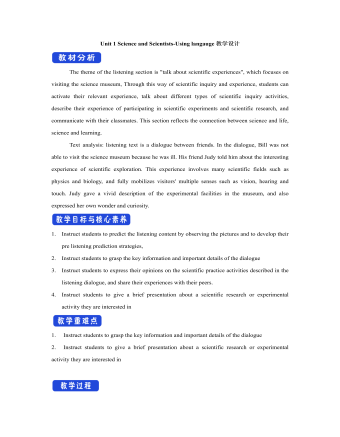
新人教版高中英语选修2Unit 1 Science and Scientists-Using langauge教学设计
This happens because the dish soap molecules have a strong negative charge, and the milk molecules have a strong positive charge. Like magnets, these molecules are attracted to each other, and so they appear to move around on the plate, taking the food coloring with them, making it look like the colors are quickly moving to escape from the soap.Listening text:? Judy: Oh, I'm so sorry that you were ill and couldn't come with us on our field trip. How are you feeling now? Better?? Bill: Much better, thanks. But how was it?? Judy: Wonderful! I especially liked an area of the museum called Light Games.it was really cool. They had a hall of mirrors where I could see myself reflected thousands of times!? Bill: A hall of mirrors can be a lot of fun. What else did they have?? Judy: Well, they had an experiment where we looked at a blue screen for a while, and then suddenly we could see tiny bright lights moving around on it. You'll never guess what those bright lights were!? Bill: Come on, tell me!? Judy: They were our own blood cells. For some reason, our eyes play tricks on us when we look at a blue screen, and we can see our own blood cells moving around like little lights! But there was another thing I liked better. I stood in front of a white light, and it cast different shadows of me in every color of the rainbow!? Bill: Oh, I wish I had been there. Tell me more!? Judy: Well, they had another area for sound. They had a giant piano keyboard that you could use your feet to play. But then, instead of playing the sounds of a piano, it played the voices of classical singers! Then they had a giant dish, and when you spoke into it, it reflected the sound back and made it louder. You could use it to speak in a whisper to someone 17 meters away.? Bill: It all sounds so cool. I wish I could have gone with you? Judy: I know, but we can go together this weekend. I'd love to go there again!? Bill: That sounds like a great idea!
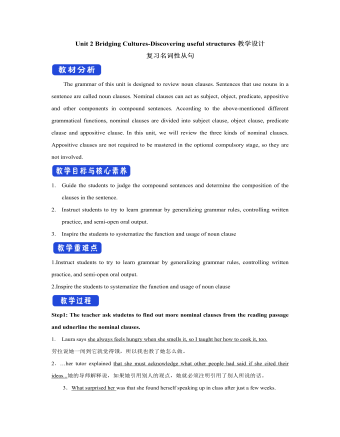
新人教版高中英语选修2Unit 2 Bridging Cultures-Discovering useful structures教学设计
The grammar of this unit is designed to review noun clauses. Sentences that use nouns in a sentence are called noun clauses. Nominal clauses can act as subject, object, predicate, appositive and other components in compound sentences. According to the above-mentioned different grammatical functions, nominal clauses are divided into subject clause, object clause, predicate clause and appositive clause. In this unit, we will review the three kinds of nominal clauses. Appositive clauses are not required to be mastered in the optional compulsory stage, so they are not involved.1. Guide the students to judge the compound sentences and determine the composition of the clauses in the sentence.2. Instruct students to try to learn grammar by generalizing grammar rules, controlling written practice, and semi-open oral output.3. Inspire the students to systematize the function and usage of noun clause1.Instruct students to try to learn grammar by generalizing grammar rules, controlling written practice, and semi-open oral output.2.Inspire the students to systematize the function and usage of noun clauseStep1: The teacher ask studetns to find out more nominal clauses from the reading passage and udnerline the nominal clauses.
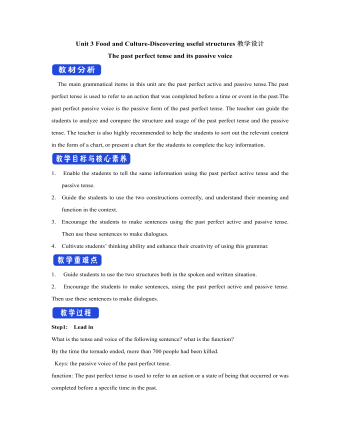
新人教版高中英语选修2Unit 3 Food and Culture-Discovering useful structures教学设计
The newspaper reported more than 100 people had been killed in the thunderstorm.报纸报道说有一百多人在暴风雨中丧生。(2)before、when、by the time、until、after、once等引导的时间状语从句的谓语是一般过去时,以及by、before后面接过去的时间时,主句动作发生在从句的动作或过去的时间之前且表示被动时,要用过去完成时的被动语态。By the time my brother was 10, he had been sent to Italy.我弟弟10岁前就已经被送到意大利了。Tons of rice had been produced by the end of last month. 到上月底已生产了好几吨大米。(3) It was the first/second/last ... time that ...句中that引导的定语从句中,主语与谓语构成被动关系时,要用过去完成时的被动语态。It was the first time that I had seen the night fact to face in one and a half years. 这是我一年半以来第一次亲眼目睹夜晚的景色。(4)在虚拟语气中,条件句表示与过去事实相反,且主语与谓语构成被动关系时,要用过去完成时的被动语态。If I had been instructed by him earlier, I would have finished the task.如果我早一点得到他的指示,我早就完成这项任务了。If I had hurried, I wouldn't have missed the train.如果我快点的话,我就不会误了火车。If you had been at the party, you would have met him. 如果你去了晚会,你就会见到他的。

新人教版高中英语选修2Unit 3 Food and Culture-Reading and thinking教学设计
The discourse explores the link between food and culture from a foreign’s perspective and it records some authentic Chinese food and illustrates the cultural meaning, gerography features and historic tradition that the food reflects. It is aimed to lead students to understand and think about the connection between food and culture. While teaching, the teacher should instruct students to find out the writing order and the writer’s experieces and feelings towards Chinese food and culture.1.Guide the students to read the text, sort out the information and dig out the topic.2.Understand the cultural connotation, regional characteristics and historical tradition of Chinese cuisine3.Understand and explore the relationship between food and people's personality4.Guide the students to use the cohesive words in the text5.Lead students to accurately grasp the real meaning of the information and improve the overall understanding ability by understanding the implied meaning behind the text.1. Enable the Ss to understand the structure and the writing style of the passage well.2. Lead the Ss to understand and think further about the connection between food and geography and local character traits.Step1: Prediction before reading. Before you read, look at the title, and the picture. What do you think this article is about?keys:It is about various culture and cuisine about a place or some countries.
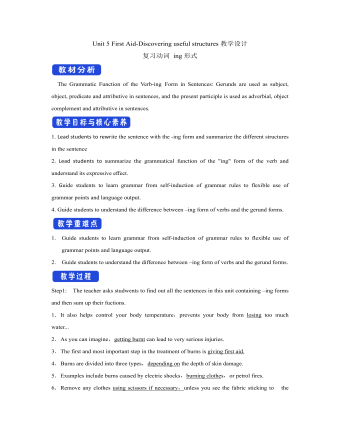
新人教版高中英语选修2Unit 5 First Aid-Discovering useful structures教学设计
You have no excuse for not going.你没有理由不去。He was punished for not having finished his homework.他因未完成作业而受到惩罚。2.动词ing形式复合结构由物主代词或人称代词宾格、名词所有格或普通格加动词ing,即“sb./sb.'s+doing”构成。动词ing形式的复合结构实际上是给动词ing形式加了一个逻辑主语。动词ing形式的复合结构有四种形式:①形容词性物主代词+动词ing②名词所有格+动词ing③代词宾格+动词ing④名词+动词ingHer coming to help encouraged all of us.她来帮忙鼓舞了我们所有人。The baby was made awake by the door suddenly shutting.这个婴儿被突然的关门声吵醒了。Can you imagine him/Jack cooking at home?你能想象他/杰克在家做饭的样子吗?无生命名词无论是作主语还是作宾语都不能用第②种形式。Tom's winning first prize last year impressed me a lot.汤姆去年得了一等奖使我印象深刻。Do you mind my/me/Jack's/Jack leaving now?你介意我/杰克现在离开吗?Excuse me for my not coming on time.很抱歉我没能按时来。His father's being ill made him worried.他父亲病了,他很担心。We are looking forward to the singer's/the singer to give us a concert.我们盼望着这位歌手来给我们举办一场演唱会。
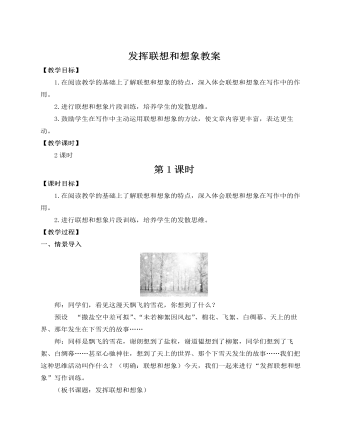
人教部编版七年级语文上册发挥联想和想象教案
【设计意图】本环节是为了突破难点而设计,以名篇佳作为范例,引导学生理解什么叫作合理而大胆的想象,示范作用明显。另外,本环节也是为下一环节——学生自由想象自己十年后的生活做铺垫。三、写作实践师:同学们,让我们拿起笔,徜徉于联想和想象的世界。1.学生写作课件出示:题目:你有没有憧憬过未来的生活?你觉得,十年以后的你是什么样子的呢?在做什么?又有着怎样的精神面貌呢?请以《十年后的我》为题,发挥想象,写一篇作文。不少于500字。思路点拨:发挥大胆而丰富的想象,可从十年后的生活变化、社会发展变化等方面着手,塑造人物的变化,如人物的相貌、心态及性格等,但性格的发展一定要符合逻辑。写法指导:选择一件事或几件事,通过语言、动作等描写来展现人物的性格。写作中也可采用前后对比的手法,如现在的“我”性格暴躁,十年后的“我”性格温顺等,通过人物的变化来反映社会的变化。
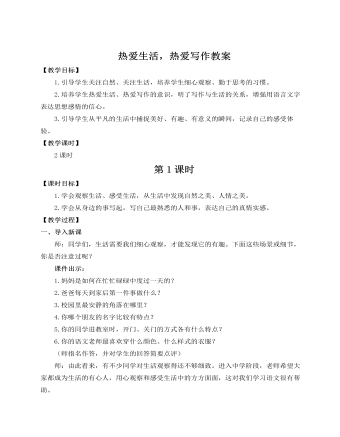
人教部编版七年级语文上册热爱生活,热爱写作教案
三、实战演练1.明确题干要求师:阅读教材P18的写作实践三,读读题干和“提示”,然后集中讨论一下,你是如何理解这个写作实践暗含的要求的。预设(1)这个题目可以简单概括为成长中的事件,范围比较宽广,类似于经常碰到的《难忘的一件事》一类的作文题。(2)一定要注意“成长”这个关键词,在描述这个事件时,一定要写出自己人生体悟的变化。(3)要选择一件有意义的、使“我”成长的事来写,在文末还应升华主题,写出自己在经历这件事后得到的人生启示。2.补充写作提示师:为了帮助大家完成好这次习作,老师在教材的基础上,还另外补充了三条“提示”。课件出示:提示:1.选材要小。选取生活中的一两个片段来刻画人物、表达感情。从小事入手,于细微处见精神,以小见大,突出“难忘”“印象深刻”。2.叙事要详略得当。叙事要围绕中心,抓住重点,把最能体现事件意义、最能展示人物形象的言行、心理描写得真实而详细。同时,要讲究剪裁,选取典型的、能揭示事物本质的、有说服力的材料表达中心思想,做到详略得当,主次分明。
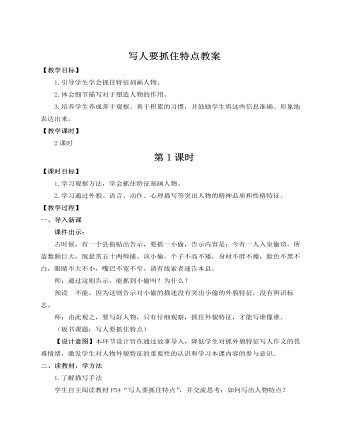
人教部编版七年级语文上册写人要抓住特点教案
【设计意图】本环节旨在引导学生明确如何围绕人物的精神品质和性格特点选择材料,刻画人物内在的个性特征。两个环节,从课内引申到课外实践,用思维导图的方式,直观易学。三、抓住细节,事中显神当我们写多件事情表现人物时,要处理好叙事的详略。详写的事情也不能面面俱到地展开叙述,而应该突出重点,要将概括叙述与具体叙述相结合,力求通过一些具体而微小的细节表现人物特点。1.例文引路,学习方法师:下面我们一起以魏巍的《我的老师》为例,学习多件事情叙述的详略安排,学习用细节刻画表现人物形象。(1)师印发并指导学生阅读魏巍的《我的老师》。(见《教师教学用书》P161第三单元写作的“例文评析”栏目)(2)明确阅读要求。课件出示:阅读要求①勾画出描写蔡老师的外貌、语言、动作、神态、心理等语句,体会语句表达的真挚感情。
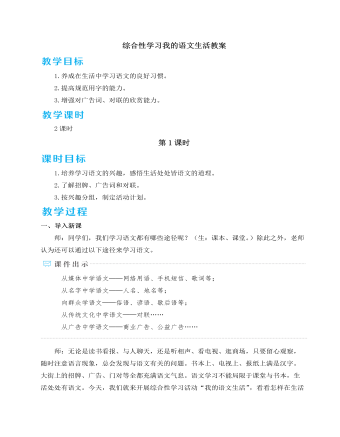
人教部编版七年级下册综合性学习我的语文生活教案
1.培养学习语文的兴趣,感悟生活处处皆语文的道理。2.了解招牌、广告词和对联。3.按兴趣分组,制定活动计划。 一、导入新课师:同学们,我们学习语文都有哪些途径呢?(生:课本、课堂。)除此之外,老师认为还可以通过以下途径来学习语文。从媒体中学语文——网络用语、手机短信、歌词等;从名字中学语文——人名、地名等;向群众学语文——俗语、谚语、歇后语等;从传统文化中学语文——对联……从广告中学语文——商业广告、公益广告…… 师:无论是读书看报、与人聊天,还是听相声、看电视、逛商场,只要留心观察,随时注意语言现象,总会发现与语文有关的问题。书本上、电视上、报纸上满是汉字。大街上的招牌、广告、门对等全都充满语文气息。语文学习不能局限于课堂与书本,生活处处有语文。今天,我们就来开展综合性学习活动“我的语文生活”,看看怎样在生活中学习语文。
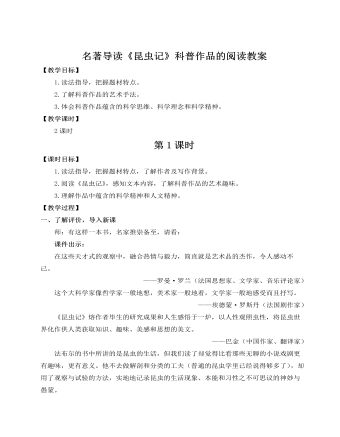
人教部编版语文八年级上册名著导读《昆虫记》 科普作品的阅读教案
整个的螳螂巢,大概可以分成三个部分。其中的一部分是由一种小片做成的,并且排列成双行,前后相互覆盖着,就好像屋顶上的瓦片一样。这种小片的边沿,有两行缺口,是用来做门路的。在小螳螂孵化的时候,就是从这个地方跑出来的。至于其他部分的墙壁,全都是不能穿过的。螳螂的卵在巢穴里面堆积成好几层。其中每一层,卵的头都是向着门口的。前面我已经提到过了,那道门有两行,分成左、右两边。所以,在这些幼虫中,有一半是从左边的门出来的,其余的则从右边的门出来。阅读感悟:作者介绍螳螂的巢时不仅对它们用的材料进行了说明,还对这两种材料做了进一步分析,而且对整个巢的构造做了详细的说明。这些正好体现出作者观察仔细、认真,乐于探究的精神。(2)法布尔科学实验的方法。综合上面两个片段,法布尔在研究昆虫时,经常采用的是观察法和实验法。课件出示:观察法可以直接用肉眼,也可以借助放大镜、显微镜等仪器,或利用照相机、录像机、摄像机等工具,有时还需要测量。
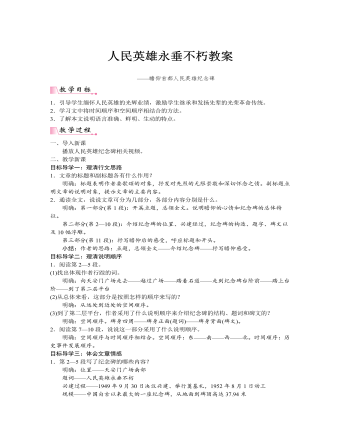
人教部编版语文八年级上册人民英雄永垂不朽教案
这篇文章的语言既有说明文语言准确、严密的特点,又有新闻特写鲜明、生动的特点,请和大家分享你最喜欢的语句,并说明理由。(学生发言)1.准确、严密示例:据地质学家化验证明,这些浮雕至少能耐800年到1000年之久。明确:“据地质学家化验证明”交代数据来源;“至少”对时间进行限定。2.鲜明、生动示例一:深夜,起义的新军和市民,摧毁了湖广总督府门前的大炮,正向总督府里冲去。总督府内熊熊的火焰冒向天空;总督府的牌子,被打断在阶前;撕碎了的清朝的龙旗,被践踏在地上。明确:“摧毁”“冲去”“冒”“打断”“撕碎”“践踏”一系列动词,准确生动地表现了起义者大无畏的革命气概,也揭示了清朝腐朽的本质。示例二:一群男女青年学生,举着“废除卖国密约”的旗帜,慷慨激昂地来到天安门前。梳着髻子、系着长裙的女学生,在向市民们散发传单。人群高处,一个男学生正在向围着他的群众演说。愤激的青年演说者,怒形于色的人群,使整个浮雕充满了痛恨卖国贼、激动人心的气氛。
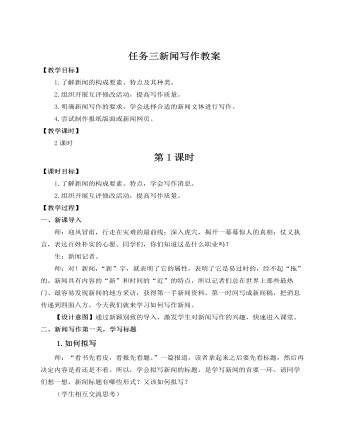
人教部编版语文八年级上册任务三新闻写作教案
五、布置作业新闻是我们了解社会、了解世界的窗口,每天都有各种各样的新闻发生。虽然新闻写作活动已经结束,但是听新闻、看新闻的活动才刚刚启幕。学了新闻写作的方法,我们再去听新闻、看新闻,就更有针对性,更能了解作者的写作意图。今天的作业比较特殊,是一个长期的作业,即希望同学们能够每天坚持至少听新闻、看新闻十分钟。结束语:同学们,明代思想家顾宪成有名联:“风声雨声读书声声声入耳;家事国事天下事事事关心。”“新闻每天发生,视角各有不同。”网络时代,我们更应该走向更广阔的世界,用一双新闻眼,发现生活中的新闻事件,传播正能量的新闻事实。这是我们的义务,也是我们光荣的责任。【设计意图】写作新闻是提升综合素质的绝佳途径之一,它让我们紧贴时代脉搏,既开阔了视野,又锻炼了思辨能力,还可以学到各种科学新知、流行文化。在学生了解了新闻写作的基本方法后,向他们提出听新闻、看新闻的要求,旨在培养他们关心时事的习惯,为他们的素养提升奠基。
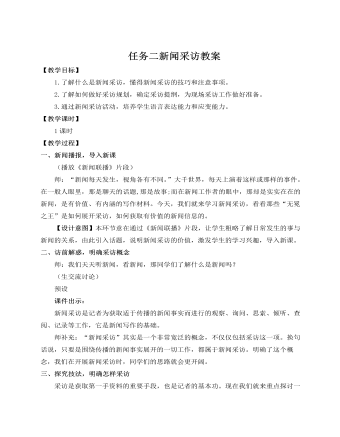
人教部编版语文八年级上册任务二新闻采访教案
【设计意图】本环节意在指导学生做好新闻采访前的准备工作。草拟新闻采访提纲,是进行新闻采访的关键环节。学生只有做好了采访前的准备工作,才能在采访过程中有的放矢,不慌不忙。五、采访实践,检验学习所得四人一个小组设计采访活动,选定采访对象,制订采访提纲进行现场采访。师点拨:采访时要注意当场做笔记,采访后要注意及时整理。整理注意点:1.整理要及时。采访一结束,就要在“记忆的黄金时段”立刻整理记录。2.整理材料应去粗存精,选择重点。整理过程中还要疏通文字,进一步补充、核实材料。3.充分发挥笔记的作用,积累新材料,写好新闻稿。结束语:这节课我们学习了新闻采访的相关知识,大家要重点掌握采访的流程与注意事项,希望通过这节课的学习能激起大家对采访的兴趣,也希望通过本节课的学习,同学们在口语表达能力上可以有一个很大的提升,也许在不远的将来,你就是一名出色的记者。
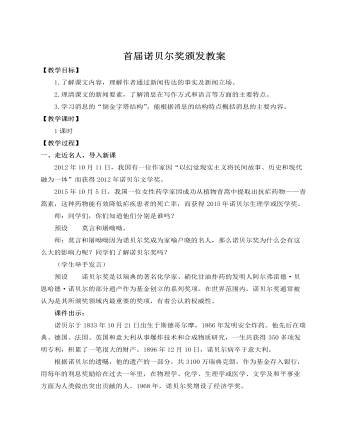
人教部编版语文八年级上册首届诺贝尔奖颁发教案
2000年,老舍先生的儿子、中国现代文学馆副馆长舒乙向外界披露了“1968年诺贝尔文学奖几乎被老舍得到”的内幕。舒乙透露,在入围者到了最后5名时还有老舍,最终,秘密投票结果的第一名就是老舍。那年,瑞典方面通过调查得知老舍已经去世,于是日本的川端康成获奖。1987、1988年诺贝尔文学奖终审名单之中,沈从文均入选,而且沈从文是1988年中最有机会获奖的候选人。诺贝尔文学奖终身评委马悦然曾透露,当时学院中有强大力量支持沈从文的候选人资格。但可惜的是,沈从文于1988年5月10日去世,因此与诺贝尔文学奖失之交臂。疑难突破《首届诺贝尔奖颁发》特别说明资金管理权和评奖权的分离,有什么用意?资金管理权和评奖权的分离能够有效保证诺贝尔奖评奖的公正性。公正性是权威性的基础,诺贝尔奖(特别是它的科技类奖项和文学奖)一百多年以来形成的权威性,与这一分离制度关系密切。就当时而言,诺贝尔奖只是首次颁发,特别需要强调其权威性。
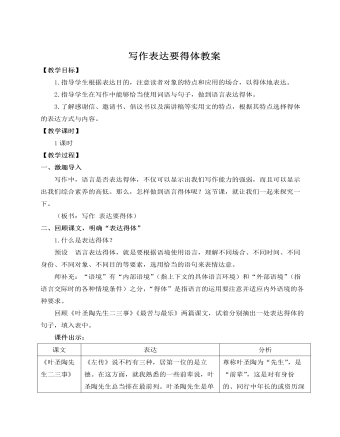
人教部编版语文八年级上册写作表达要得体教案
预设 这篇邀请函格式正确、要素齐全、语言得体。主要表现在:标题直接点明邀请的目的,清晰醒目;格式上有称呼、问候语、祝颂语、落款,符合邀请函的基本格式要求;正文中有邀请的理由,让家长明确被邀请的原因;有活动的时间、地点,以及启动仪式的流程和注意事项,让被邀请者有所了解和准备,更显真诚、有礼。整个邀请函,态度诚恳,简洁明了,表达得体。3.拓展迁移,把握书信体应用文写作格式师:请同学们探讨一下,采用书信格式写作的应用文还有哪些?它们的共同点是什么?预设 感谢信、慰问信、表扬信、申请书(请假条)、倡议书、介绍信、证明信、求职信、应聘信、祝贺信、请柬等。格式一般由六个部分构成,即标题、称呼、问候语、正文、祝颂语、落款。
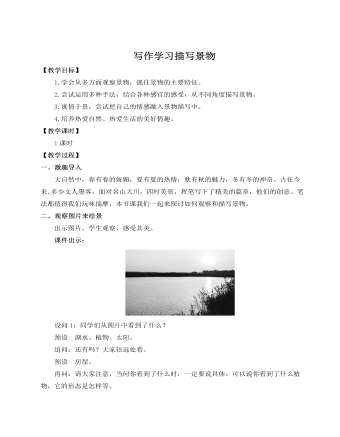
人教部编版语文八年级上册写作学习描写景物教案
原文:我呆呆地坐在窗前,望着窗外天上的月亮……我和妈妈又吵架了,我伤心地哭了。改文:我呆呆地坐在窗前,望着窗外天上的月亮,它升起来了,冰冷地挂在枝头,月色淡白,月影斑驳,月光凄凉地洒向大地……我和妈妈又吵架了,我伤心地哭了。预设 修改后的片段把干瘪无味的语句变得生动形象。选取月亮展开描写,运用“冰冷”“淡白”“斑驳”“凄凉”等冷色调词语来渲染气氛,衬托“我”吵架后沮丧、失落、难过的心情。写作时可以恰当选用词语,运用多种手法写景,以达到渲染氛围的作用。【设计意图】此环节旨在通过升格扩充,让学生小试牛刀,达到学以致用的目的。五、实战演练绘家乡家乡,生我们养我们的地方;家乡,令我们魂牵梦绕的地方;家乡,人生起航的地方。家乡的一草一木、一山一水,必然印在我们的脑海,烙在我们的心上。请你拿起手中的笔,以《家乡一景》为题,描写出这处景物的特征及给你的独特感受,不少于500字。
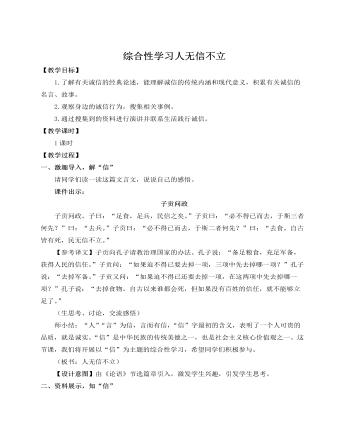
人教部编版语文八年级上册综合性学习人无信不立教案
预设 (1)苏州某生物科技有限公司生产假口罩和知名校长胡红梅抄袭的行为与中华民族的传统美德相悖。(2)只有讲诚信,社会才会文明,国家才会兴盛。3.学生列举身边关于诚信的故事,小组交流,全班展示,师适时点拨、总结、评价。师小结:坚持诚信,就会赢得信任,诚信是获得信任的前提。【设计意图】通过事例分析,引导学生对不诚信行为的认识,从而进一步了解诚信的重要性。四、演讲实践,说“信”学生活动:1.根据自己的理解,写一篇演讲稿,说说如何才能做一个有诚信的人。2.全班交流讨论。教师活动:1.根据学生的交流,及时做出总结评价。2.归纳总结,引导学生形成“说诚信话,做诚信事,做诚信人”的行为准则。师小结:诚信是为人之本,相信今天的诚信教育仅仅是我们迈向成功人生的第一步。诚信的力量可以点石成金。我们要崇尚诚信:身披一袭灿烂,心系一份执着,带着诚信上路。
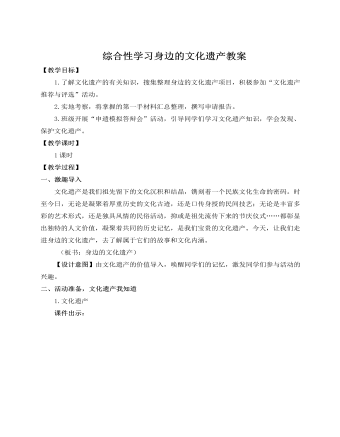
人教部编版语文八年级上册综合性学习身边的文化遗产教案
预设 1.树立保护文化遗产的意识,从小事做起,从自身做起。2.向周边的人宣传保护文化遗产的重要性,让人们明白文化遗产是民族精神的底蕴、民族文化的根基。3.向当地政府部门提出保护文化遗产的合理方案:(1)必须以法律条文的形式进行规范和监督,维护重奖,破坏严惩。(2)开办文化遗产学习、讲座、知识竞赛等活动。让人们耳濡目染,感受中华传统文化遗产的魅力和文化遗产存在的必要性。4.用实际行动保护它,同破坏它的人进行坚决的斗争。结合教材P148“资料三”和P149“资料四”,以“我与文化遗产”为话题,自拟题目,写一篇作文,谈谈你对文化遗产保护的认识和思考。【设计意图】本环节意在让学生在参与活动的基础上,进一步反思。通过问题设计和写作训练,进一步梳理探索过程,扩展实践探索的思想广度,将活动引入到更深的层次,提升了活动的效果。















 QQ登录
QQ登录 微信登录
微信登录